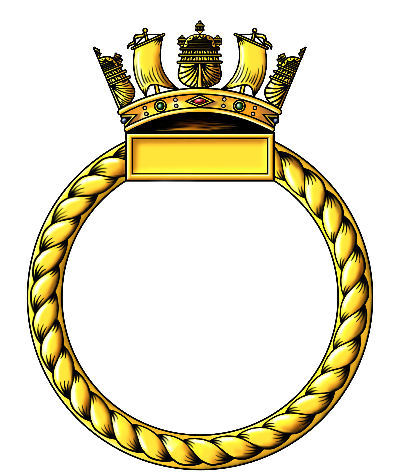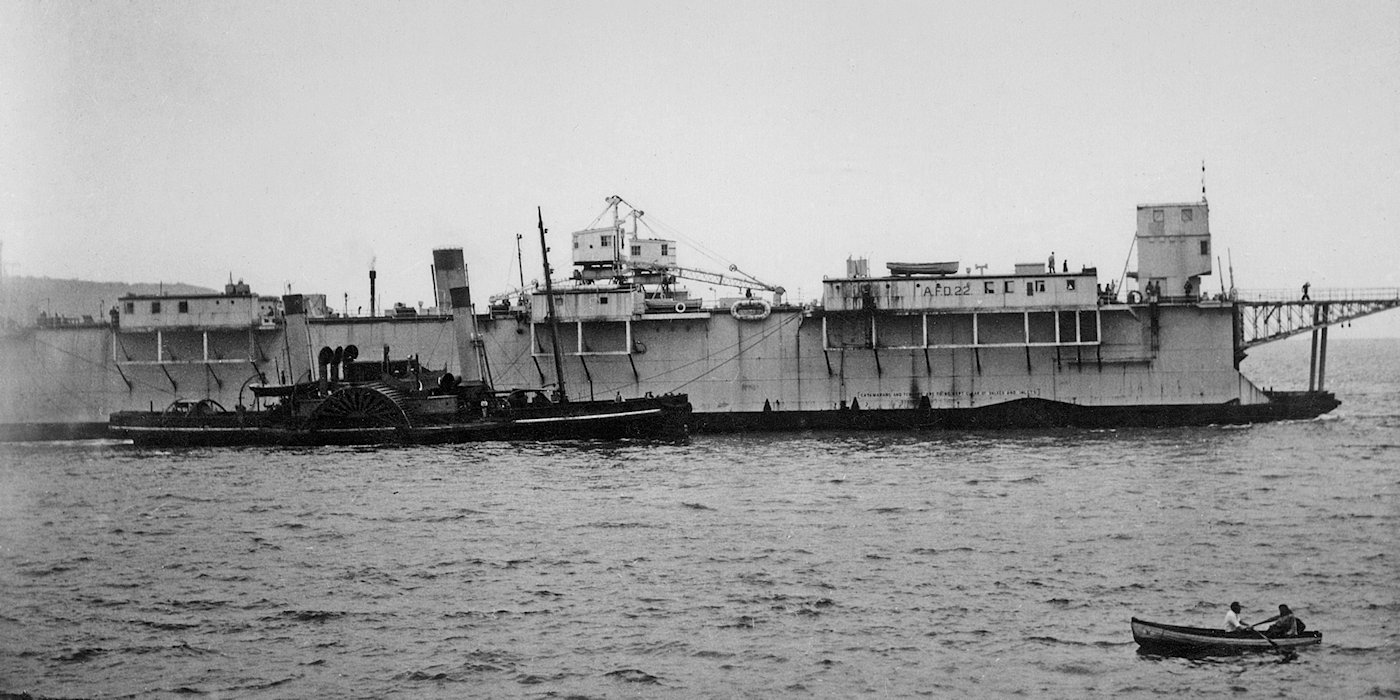Admiralty Floating Dock

Battle Honours
None
Specifications
Builder: Devonport Naval Dockyard, Plymouth, Devon, England
Length: Overall - 380 ft; Pontoons - 350 ft
Width: 50 ft internal
Lifting Capacity: 2,775 tons
Crew complement: 35
Commanding Officers
Warrant-Shipwright W. J. Trist, RN
Lieutenant E.F. Williams, RNVR
Related items
None
Reminiscences
None
A.F.D. 17

A 2,750 tons lifting capacity Clark Stanfield design dock
Early history
Admiralty Floating Dock No 17 was built by Devonport Naval Dockyard, Plymouth, to a Clark Stanfield design with a lifting capacity of 2750 tons, originally intended for the emergency docking of escort vessels and destroyers. On completion in September 1942 she was towed to Reykjavik, Iceland leaving Plymouth on September 23rd under tow by the tug FREEBOOTER. There she was under the control of HMS BALDUR, the RN depot at Reykjavik until September 1944 when she was reassigned for duty with the British pacific Fleet.
Allocated to the British Pacific Fleet
The dock was about to undertake the longest ocean tow in history, Reykjavik to Sydney, a 16,000-mile voyage lasting nine months. During the tow, which was undertaken in several stages, the dock was manned by 32 Royal Navy personnel under the charge of Warrant-Shipwright W. J. Trist, RN.
AFD 17 departed Reykjavik for the Clyde on September 13th 1944 under tow by rescue tugs SAUCY and LARIAT, escorted by the ASW trawlers KIRKELLA, NORTHERN SPRAY and BRIMNES. From the Clyde the tow continued to Gibraltar escorted by ASW trawlers NORTHERN SPRAY, NORTHERN REWARD and COLDSTREAMER.
The weather in the Northern Atlantic was to slow the tow considerably; severe gales battered the dock and her tugs. The worst lasted for ten days and nights during which time the 18-inch-thick tow ropes broke under the strain on five occasions and at one point the dock drifted for three days before the tow could be re-established. During one spell of this bad weather a five-ton travelling crane mounted on top of the starboard wall broke loose and there was a frantic two hours when there was a constant danger that the crane would run overboard before it could be made fast. On Thursday September 28th tragedy struck when Able Seaman Lyon was knocked overboard when a tow line parted on LARIAT. On reaching Gibraltar the dock had to undergo repairs before continuing on the next leg to Aden via the Suez Canal.
On departing from Gibraltar LARIAT was joined by two other (unidentified) tugs, LARIAT ahead of the dock and the two smaller ones on either bow, escort was provided by the South African Whaler HMSAS SOUTHERN SEAS and several ASW trawlers. Three days out the weather deteriorated again and the tugs had to fight against gale force winds to keep the dock from being blown into off shore minefields off the North African coast near Oran.
After passage through the Suez Canal AFD 17 arrived at Aden December 12th to refuel and store ship before departing for Cochin on December 20th under tow by LARIAT and an unknown Second tug (INTEGRITY?), under escort of the corvette BUGLOSS. She arrived at Cochin in Southern India on January 8th 1945 and remained there for a month before continuing on to Fremantle, Western Australia. It had been planned that a third tug, EMPIRE SAM, should join the small convoy, to be towed astern of AFD 17 to Fremantle; the plan was abandoned when it became apparent that this was not a workable idea and the dock sailed on February 13th still under tow from INTEGRITY and LARIAT, escorted by corvette MEADOWSWEET.
The small convoy arrived in Sydney at the end of May 1945. The dock had suffered other damaged during the many legs of the journey and so could not become operational upon her arrival; she was sent to Mort's Dock for initial repairs before being towed to Cockatoo Dockyard, for further work. AFD 17 was to see no active duty with the British Pacific Fleet; she was still in the hands of Cockatoo Dockyard when the war ended.
Post War
She entered the Captain Cook Dock for eight days of repair work on Jan 7th 1946 undocking on the 15th. On completion of her repairs she was berthed at the Fitzroy Wharf, Cockatoo Island and was transferred on loan to the Royal Australian Navy. It is unclear how long the repairs took to complete; however, it was not until December 17th 1946 that she made her first docking, lifting the 384 t Australian tug LINDFIELD. After several years of wrangling over her value the Australian Government purchased AFD 17 for the sum of £75,000 in 1948.
During her 22 years of service with the Royal Australian Navy AFD 17 completed 641 dockings of RAN and RN vessels, ranging in size from tugs to frigates and submarines. She condemned in 1957 as too expensive to repair. This situation appears to be the result of reluctance on the Australian government’s part to spend any serious money on her upkeep but the usefulness of her two 5 ton electric cranes earned her a short reprieve. Despite the Royal Australian Navy’s willingness to discard her she was still utilised to her fullest, completing 58 dockings the following year.
Her last docking was the RN submarine HMS TACITURN on March 24th 1964, after which she was finally withdrawn from service and sold for scrap. The two electric cranes were salvaged from her before her carcass was towed away; these were installed at Fitzroy Wharf where they remained in use until the wharf was closed in 1991.
Note: It is assumed that SAUCY continued the tow to Gibraltar. She is recorded as being in Barry Docks on October 20th 1944.
Last modified: 23 February 2023
Primary information sources
Additional sources:
Admiralty War Diaries September 1944
Electronically sourced via Fold3.com Accessed 02 January 2015
Admiralty War Diaries December 1944
Electronically sourced via Fold3.com Accessed 02 January 2015
For King and Country -WW II Reminiscences of Nelson Albert Tomalin R.N.V.R
Account of HMSAS SOUTHERN SEAS escorting the dock in the Mediterranean Accessed 31 December 2014
Jeremy, J. (2005) ‘Cockatoo Island: Sydney's Historic Dockyard’ Sydney, University of New South Wales [Pages 60-61]
accessed via
Google books 28 Dec 2014
Article - 'heir home aboard a floating dock'

Comments (0)